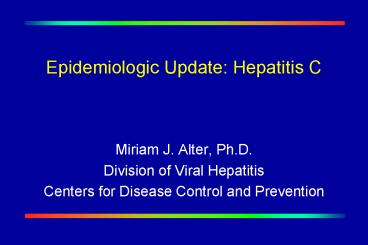Epidemiologic Update: Hepatitis C - PowerPoint PPT Presentation
1 / 20
Title:
Epidemiologic Update: Hepatitis C
Description:
Clinical entity (non-A, non-B hepatitis) in transfused patients reported late 1960s ... Characterized the epidemiology. Documented 80% decline in incidence ... – PowerPoint PPT presentation
Number of Views:36
Avg rating:3.0/5.0
Title: Epidemiologic Update: Hepatitis C
1
Epidemiologic Update Hepatitis C
- Miriam J. Alter, Ph.D.
- Division of Viral Hepatitis
- Centers for Disease Control and Prevention
2
Hepatitis C Virus Infection
- Clinical entity (non-A, non-B hepatitis) in
transfused patients reported late 1960s - RNA Flavivirus (Hepacivirus)
- Discovered using recombinant DNA technology 1989
- Bloodborne (primarily) and sexually-transmitted
- Vaccine difficult to develop
- Mutations occur during viral replication
- Substantial heterogeneity (quasispecies) selects
for neutralization escape variants
3
HCV Accomplishments During Past 15 Years
- Determined burden of infection and morbidity in
the general population - Eliminated transfusion-associated infections
- Characterized the epidemiology
- Documented gt80 decline in incidence
- Implemented community-based prevention
- Slowed rates of infection in new IDUs
- Vaccine developed that may prevent chronic
infection (subtype specific) - Tissue culture systems effective for growing
infectious virus - May speed development of new antivirals
4
Hepatitis C Virus Infection, United States
- New infections per year 1985-89 242,000
- 2003 30,000
- Persons ever infected (1.6) 4.1 million
(3.4-4.9) - Persons with chronic infection 3.1 million
(2.5-3.7) - HCV-positives tested ?40
- Persons with HIV co-infection ?225,000
95 confidence interval (data from NHANES
1999-2002
5
Estimated Incidence of Acute HCV, U.S.
N240,000/yr
Decline in injection drug users
N30,000
Decline in transfusion recipients
?
Source Armstrong GL. Hepatology 200031777-82
Alter MJ. Hepatology 19972662S-65S CDC,
unpublished data
6
Prevalence of HCV Infection in the General
Population by Age, U.S., 1988-2002
Source NHANES Alter MJ, NEJM 1999341556-562
Armstrong GL, Ann Intern Med 2006, in press
7
Distribution of HCV Genotypes in the US General
Population, NHANES, 1988-1994
Nainan et al. Gastroenterology 2006, in press
8
Risk Factors Associated With Acquiring HCV
Infection
- Transfusion, transplant from infectious donor
- Injecting drug use
- Occupational blood exposure (needle sticks)
- Birth to an infected mother
- Infected sex partner
- Multiple heterosexual partners
9
Outbreaks of HCV Infections Clustered in Time
and Place
- Health-care related transmission
- In- and outpatient care, long-term dialysis
- Most due to unsafe injection practices
- Finger stick devices, multi-dose medication
vials, reuse of syringes/needles for anesthesia,
pain management, saline flushes - Sexual transmission among HIV-pos. MSM
- Reported from France and UK
10
Relative Efficiency of HBV, HCV, HIV Transmission
by Type of Exposure
Type of exposure Efficiency of transmission to
infected source HBV HCV HIV Transfusion
Injecting drug use Unsafe
injections Needlestick lt Sexual
Perinatal Non-intact
skin /- /- Intact skin - - -
11
Relative Infectivity of HBV, HCV, HIV
HBV HCV HIV Copies/mL 108-9
105 103 Environmental stability
- Infectious after drying at room
temperature gt7 days gt16 h 0
Sources Bond Lancet 1981 Krawczynski Hepatology
2003
12
Effect of Environmental Stability on Transmission
of HCV and HBV
- More rapid acquisition among IDUs
- Associated with sharing drug preparation
equipment (i.e., cookers and cotton) - Clean needles and syringes insufficient to
interrupt transmission - Facilitates iatrogenic transmission
- Patient-to-patient from contaminated multi-dose
vials, reused needles and syringes
13
Prevalence of Chronic HBV and HCV in HIV
Positives by HIV Risk Group
HIV risk group
Denis F, Pathol Biol 1997 Thio CL, Lancet 2002
Sherman K, CID 2002, Kellerman S JID 2003
Konopnicki D, AIDS 2005
14
Exposures Not Associated With Acquiring HCV Case
Control Studies of Acute Hepatitis C, U.S.,
1979-85
Cases Controls Exposure (prior 6 months) n148
n200 Medical care procedures 30.4 29.5 Denta
l work 24.3 23.5 Health care work (no blood
contact) 4.1 5.0 Ear piercing 2.7
3.0 Tattooing 0.7 0.5 Acupuncture 0
1.0
Sources JID 1982145886-93 JAMA
19892621201-5.
15
Presence of a Risk FactorDoes Not Necessarily
Equate WithIncreased Risk
16
HCV Prevalence by Selected GroupsUnited States
17
HCV Prevalence in Selected Groups of Adults
United States
18
HCV Prevalence in Selected Groups of Adults by
History of Injection Drug Use, United States
19
Screening for IDU Efficiently Identifies Most
HCV-Positives
Setting and Criteria Screened HCV Pos STD
clients 3356 165 (5) IDU, transfusion
lt1992 12 70 Incoming prison
inmates 1148 152 (13) IDU 11 61 IDU,
hx liver disease 13 70 General population
20-59 years old IDU, transfusion lt1992
7 53 IDU, transfusion lt1992, abnl ALT
18 85
Source Gunn RA, Sex Transm Dis 2003 D Burnett,
Wisconsin Armstrong GL, Annals 2006.
20
Progress in HCV Prevention and Control Among
Injecting Drug Users
- Cumulative infection rates have slowed
- 30 prevalence after 2-3 years
- Harm reduction messages more HCV-specific
- All drug paraphernalia, not just needles/syringes
- Incidence still remains high
- 15 annual rate
- Accounts for 60-70 of all new infections































